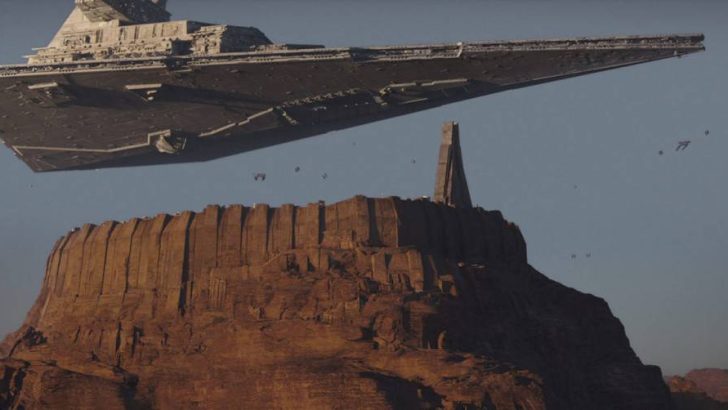Anyone who is familiar with Star Wars knows that the movie franchise is about space wizards, princesses, and an ongoing civil war between two opposing factions: the Imperials and the Rebels. One of the items in the Imperial’s navy is the iconic Star Destroyer, a massive ship with tremendous firepower. In Rogue One, it is seen that a Star Destroyer is floating in atmosphere over city, which is a new development in the franchise.
How do Star Destroyers hover? In the franchise and the
books, many crafts seem to float weightlessly above the ground. In the first
few opening scenes of A New Hope,
First, I believe it is a good idea to assert that the Star Wars franchise is not science fiction, which is based on real world science and both current and future, but science fantasy, which has elements of both science fiction and fantasy. I will reinforce this statement with two words, space wizards. There is no real-world technology that exists to explain how star destroyers hover in atmosphere. However, there are in universe explanations.
How Star Destroyers Hover: Repulsorlift Technology
According to Star Wars Legends, repulsorlift technology is an engine capable of generating an anti-gravity effect. Supposedly this effect is caused by ‘knots’ in space time. The effect of these knots is that the field they generate allows for levitation by pushing against the gravity in a gravity well, such as the pull of a planet or moon.
In Star Wars, repulsorlift technology is widely used in all manner of vehicle, from speeder bikes to large space craft. Many of the large space crafts in Star Wars that were capable of landing on a planet’s surface could only do so because they incorporated repulsorlift technology into their construction. This is how a ship over a mile long, such as a Star Destroyer, is capable of landing on the surface of a planet or moon.
Large spacecraft in the Star Wars universe often have many repulsorlift engines that are arranged in an array and have a dedicated antigravity generator on the craft itself.
It is interesting to note, however, that repulsorlift vehicles cannot travel through shields. This is evident in the scenes of the battle of Naboo. This would mean that a large ship cannot pass into the atmosphere of a planet if it has an active Planetary Shield.
So, there you have it. Star Destroyers can hover in atmosphere due to Repulsorlift technology. However, even in a fantasy world, this technology is not without limitations. Star Destroyers are insanely large and heavy vehicles.
For instance, an Imperial I Star Destroyer:
- Were approximately 1.6 miles long.
- Weighed in at around 5 million tons. This number is drawn from a Forbes article wondering how much it would cost to build a Star Destroyer.
This would require all the power from a Star Destroyers antigrav generators in order to maintain hover while in atmosphere.
Fact or Fiction: Similar Real-World Technology
Some super neat real-world technologies that mimic the hovering effect of Star Destroyers are currently undergoing research and development right now. For instance, in you are familiar with Back to the Future, then you might remember the hoverboards that were in that film series.
The real world Lexus Hoverboard, shown here, mimics the look and action of these fictional hoverboards. They really do just hover in the air. This is due to the hoverboard utilizing an effect known as the Meissner Effect, which describes the magnetic properties a superconductor has when a magnetic field is applied to it. This is one of the defining elements of superconductors.
What this effect allows a superconductor to accomplish when a magnetic field is applied to it is to lock into the magnetic field at a controlled height. This causes the Lexus Hoverboard to hover when placed on a magnetic track. The effect of the superconductors is strong enough to allow a person to stand on the board and float effortlessly across a magnetic field.
This is a similar action as to how repulsorlift technology works in Star Wars. If you noticed how the hovercrafts in Star Wars move at a seemingly predetermined distance above the ground and watch the video in the link above, I’m sure you can draw your own conclusions. Repulsorlift technology and this have very similar properties.
While the Lexus Hoverboard currently requires a magnetic track in order to operate, the repulsorlift tech does not. It’s interesting to point out that the earth itself generates its own very intense magnetic field; this is part of the reason life has been able to evolve here. Earth’s magnetic field shields us from deadly cosmic radiation that would otherwise make life incapable of development.
Maybe in the future, even the near future, a similar technology that the Lexus Hoverboard uses will come into being, allowing us to interact not with just with a magnetic track but also with the Earth’s own magnetic field. Who knows, the near future is filled with many exciting and terrifying technologies, but it would be a revolutionary one, potentially reducing the problem of leaving the atmosphere to something more akin to how a Star Destroyer handles it.
How Do Star Destroyers Survive Entry into the Atmosphere
Since these crafts are so large, it makes you wonder why the Star Destroyers didn’t break up in atmosphere. They were made for space travel, thus are huge vessels, and in space it is theoretically possible to have a craft the size of a small moon. However, this doesn’t account for the massive forces at play when the craft is moving.
When any object in the gravity well of a planet moves, it is subject to what is know as g-force. G-force is the amount of force exerted per unit of mass. When a modern-day fighter pilot executes maneuvers in air, their craft and their bodies experience rapid changes and fluctuations in the g-forces that are being exerted on their bodies.
The same goes for astronauts, who during a launch will often experience up to 3 G’s, which means they feel 3x’s the amount of Earth’s gravity. A person like myself, who weighs a mere 145lbs of twisted steel and sex appeal, would theoretically weigh about 335lbs during rocket launch. In space, objects are weightless, because weight is a unit of measurement the force of gravity, created by the mass of an object.
This change of force experienced can have dramatic effects not only on the body, making it incredibly difficult for the heart to send blood to the brain, but also on the structural integrity of the craft itself. This is no different in the Star Wars universe. So even though we have a good understanding of how a craft the size of a Star Destroyer can hover and seemingly float in atmosphere, it creates the question of how it survived entry into the gravity well.
Inertial Dampeners
Inertial Dampeners are the answer to this problem, a technology that exists in the Star Wars universe to counteract the forces of gravity on spacecraft and those aboard them. Inertial dampeners, or inertial compensators, are a piece of Star Wars technology that absorbs the inertia created by a vessel as it moved through space when it accelerated or decelerated.
This is a piece of technology that is incredibly vital to the space-faring peoples of Star Wars, as the acceleration of their crafts are often sudden and violently so. An Executor Class Star Destroyer can accelerate so quickly that it can create a force of over 1,000 g’s. The human body only can withstand around 5g’s where g-forces are lethal for us.
Without an inertial dampener onboard:
- When a ship accelerated in space, the effect would be anything that isn’t bolted down would be hit with the body of the ship that was moving forward.
- All humans on board the vessel would likely be reduced to smears of paint.
- Star Destroyers are so large that they would likely just be torn asunder from the gravity well of a planet unless the craft itself was able to manipulate its gravity and those of the objects within.
Coupling the technologies of inertial dampeners and repulsorlift technology is what allows a craft to sustain the stresses of entering and exiting the atmosphere of a planet. Even accelerating in space would be enough to turn a Star Destroyer into an artificial meteor storm.
The cool thing about this is that it negates escape velocity, which is a real-world problem when it comes to space travel. Since we don’t have access to hand waving for real world problems, unless you are a politician of course, then an object needs to be moving at a rate of 11.2 km/s in order to escape the pull of Earth’s gravity well. So, a Star Destroyer can move as slowly or quickly as its power reserves can account for while maneuvering around the atmosphere of a planet.
Photo in the Header: Rogue One: A Star Wars Story (2016) (Fair use)






Leave a comment
You must be logged in to post a comment.